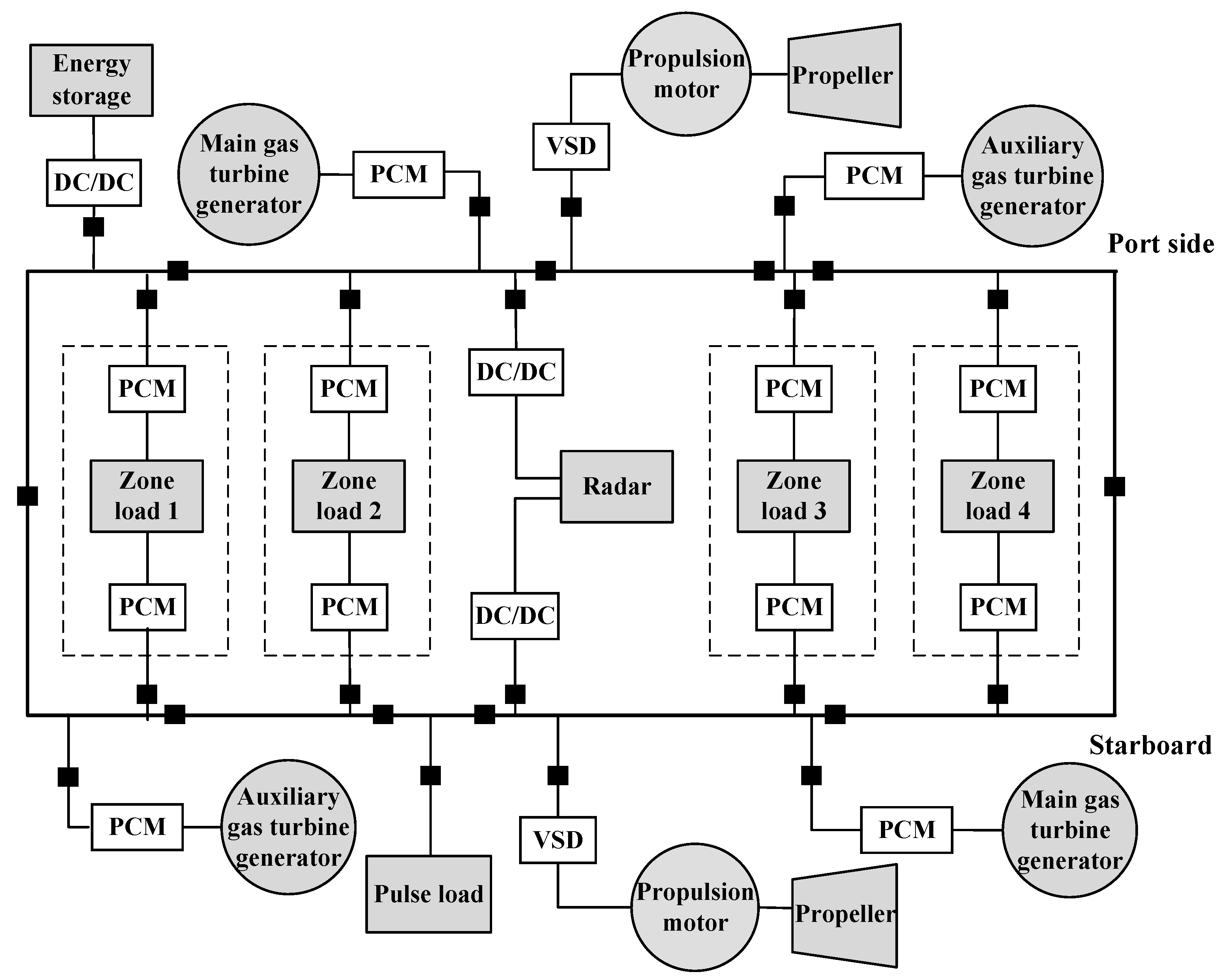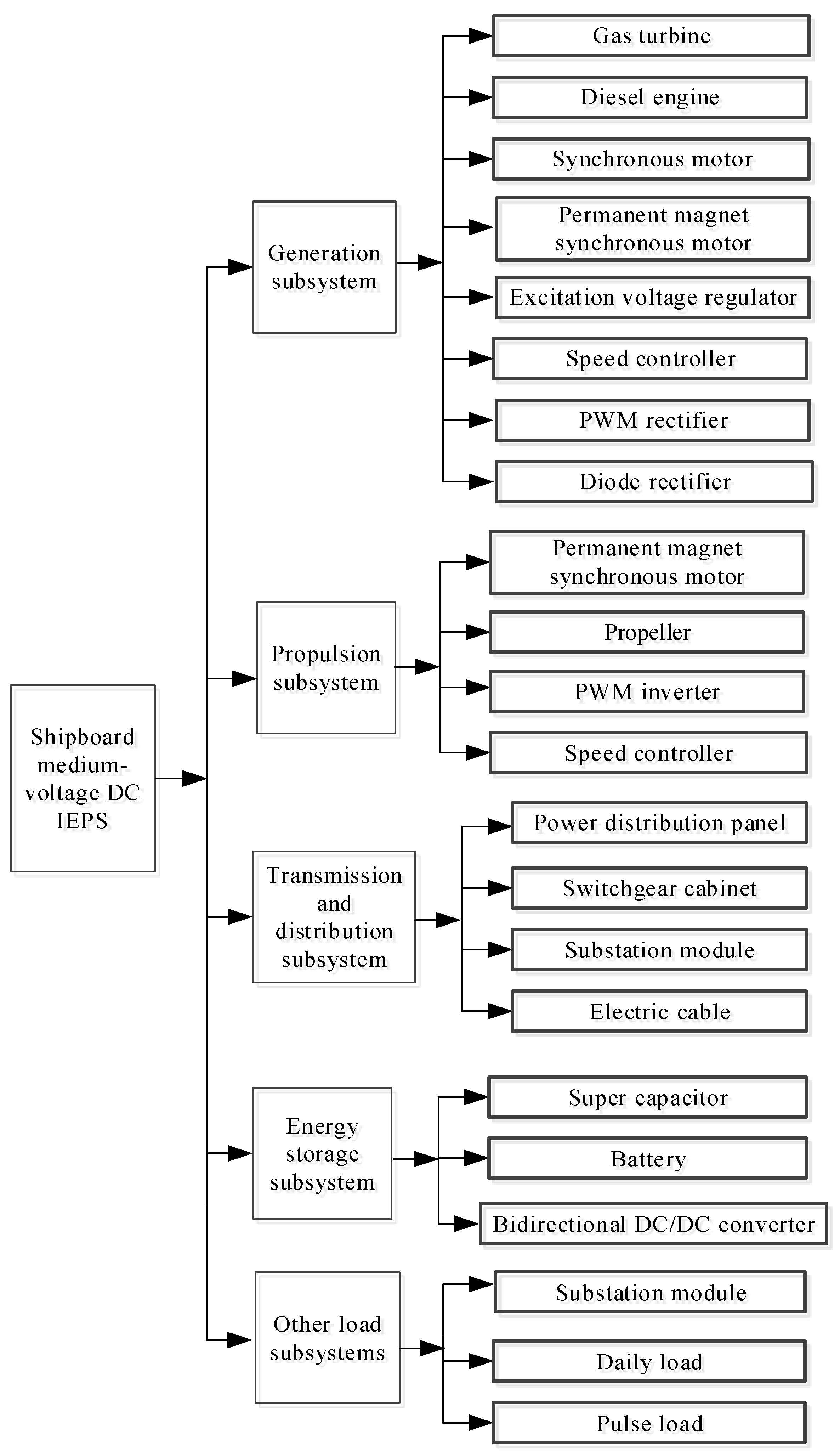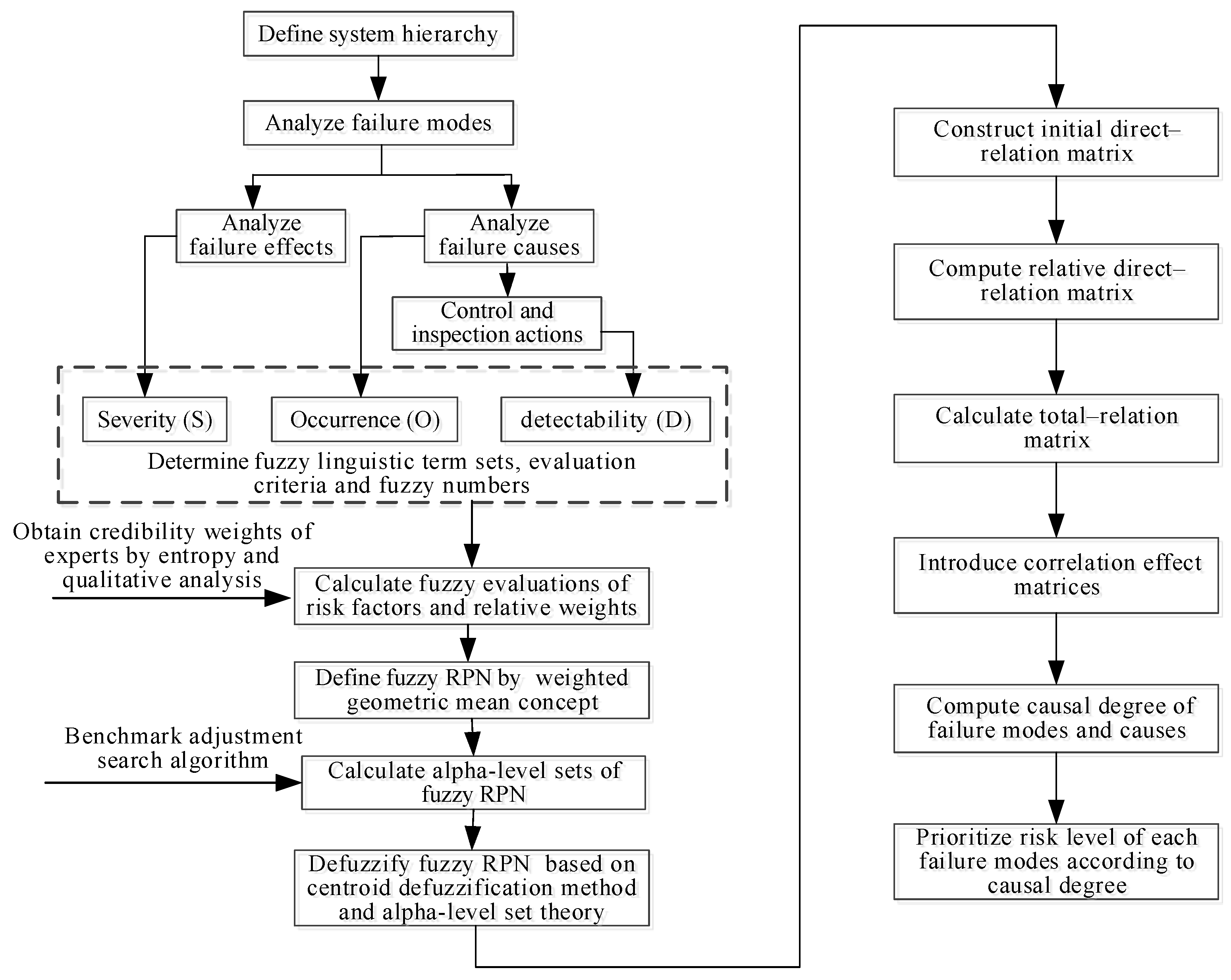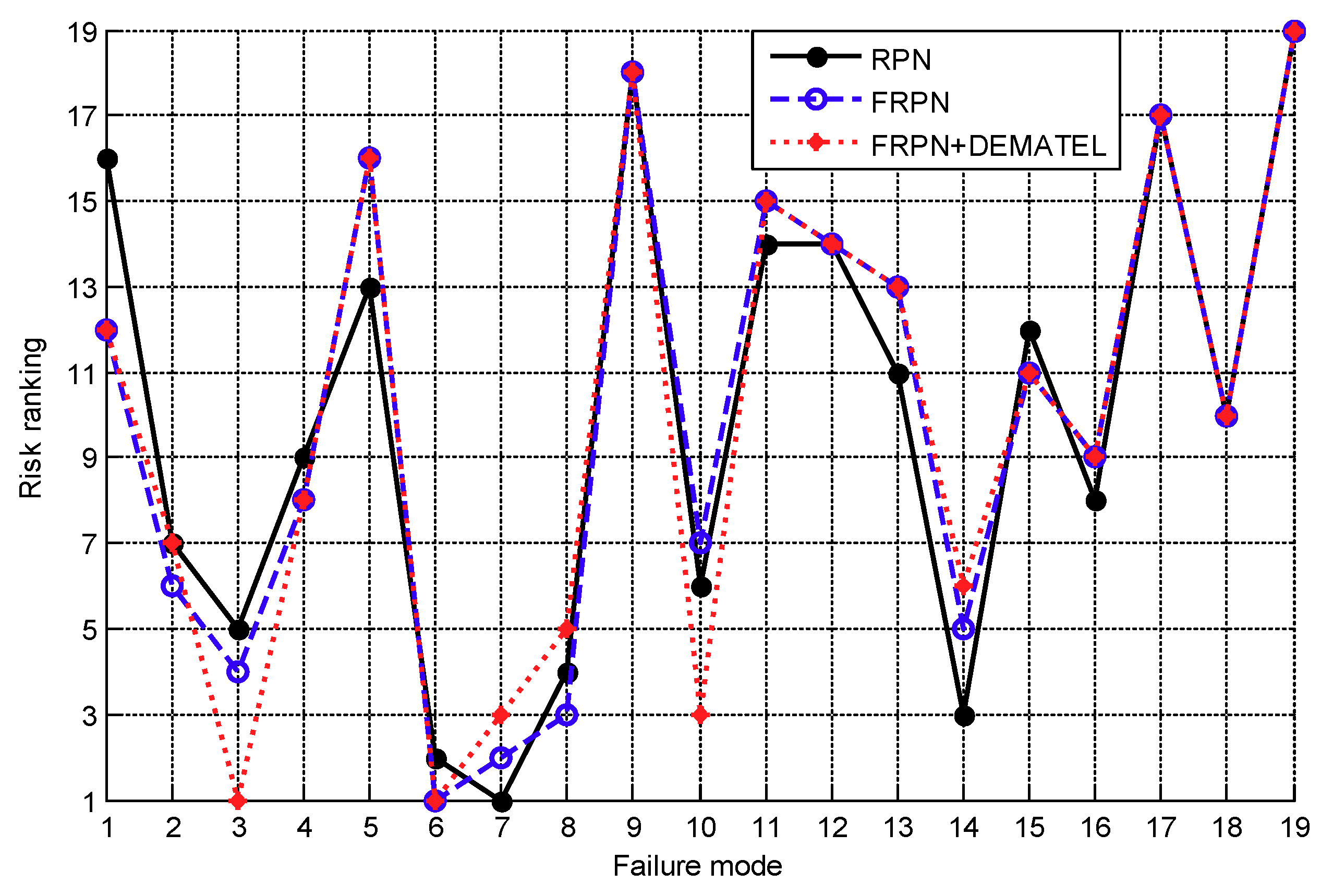An Improved Assessment Method for FMEA for a Shipboard Integrated Electric Propulsion System Using Fuzzy Logic and DEMATEL Theory
Abstract
:1. Introduction
2. System Hierarchy Description
3. The Proposed Method Integrating Fuzzy Logic and DEMATEL Theory
3.1. Fuzzy Linguistic Term Sets
3.2. Fuzzy Evaluations of Risk Factors and Relative Weights
3.3. Alpha-Level Set Calculation with Benchmark Adjustment Search Algorithm
3.4. Defuzzification of Fuzzy RPNs
3.5. DEMATEL Technique
4. Case Application and Results Analysis
4.1. Failure Mode Analysis of the Propulsion Subsystem
4.2. Calculation Results and Comparative Analysis
5. Conclusions
Author Contributions
Funding
Conflicts of Interest
References
- Shi, J.; Amgai, R.; Abdelwahed, S. Modelling of shipboard medium-voltage direct current system for system level dynamic analysis. IET Electr. Syst. Transp. 2015, 5, 156–165. [Google Scholar] [CrossRef]
- Chen, Y.; Li, Z.; Zhao, S.; Wei, X.; Kang, Y. Design and implementation of a modular multilevel converter with hierarchical redundancy ability for electric ship MVDC system. IEEE J. Emerg. Sel. Top. Power Electron. 2017, 5, 189–202. [Google Scholar] [CrossRef]
- Cuzner, R.M.; Singh, V. Future shipboard MVdc system protection requirements and solid–state protective device topological tradeoffs. IEEE J. Emerg. Sel. Top. Power Electron. 2017, 5, 244–259. [Google Scholar] [CrossRef]
- Li, W.; Monti, A.; Ponci, F. Fault detection and classification in medium voltage DC shipboard power systems with wavelets and artificial neural networks. IEEE T Instrum. Meas. 2014, 63, 2651–2665. [Google Scholar] [CrossRef]
- Wang, Y.C.; Yu, Z.Q.; He, J.L.; Chen, S.M.; Zeng, R.; Zhang, B. Performance of shipboard medium-voltage DC system of various grounding modes under monopole ground fault. IEEE Trans. Ind. Appl. 2015, 51, 5002–5009. [Google Scholar] [CrossRef]
- Robert, M.C.; Daniel, A.E. Fault tolerant shipboard MVDC architectures. In Proceedings of the 2015 International Conference on Electrical Systems for Aircraft, Railway, Ship Propulsion and Road Vehicles (ESARS), Aachen, Germany, 3–5 March 2015; pp. 1–6. [Google Scholar]
- Mareike, L.; Athanasios, K. A review of reliability–based methods for risk analysis and their application in the offshore wind industry. Renew. Sustain. Energy Rev. 2018, 91, 1065–1076. [Google Scholar]
- Christian, S.; Davide, R.; Caterina, R. A state–of–the-art review of FMEA/FMECA including patents. Comput. Sci. Rev. 2017, 25, 19–28. [Google Scholar]
- Jia, H.; Li, Z.J.; Liu, H.C. New approach for failure mode and effect analysis using linguistic distribution assessments and TODIM method. Reliab. Eng. Syst. Saf. 2017, 167, 302–309. [Google Scholar]
- Alrifaey, M.; Hong, T.S.; Supeni, E.E.; As’arry, A.; Ang, C.K. Identification and prioritization of risk factors in an electrical generator based on the hybrid FMEA framework. Energies 2019, 12, 649. [Google Scholar] [CrossRef]
- Zhou, Q.J.; Vinh, V.T. Fuzzy and grey theories in failure mode and effect analysis for tanker equipment failure prediction. Saf. Sci. 2016, 83, 74–79. [Google Scholar] [CrossRef]
- Liu, H.C.; Liu, L.; Liu, N. Risk evaluation approaches in failure mode and effects analysis: A literature review. Expert Syst. Appl. 2013, 40, 828–838. [Google Scholar] [CrossRef]
- Dağsuyu, C.; Göçmen, E.; Narlı, M.; Kokangül, A. Classical and fuzzy FMEA risk analysis in a sterilization unit. Comput. Ind. Eng. 2016, 101, 286–294. [Google Scholar] [CrossRef]
- Chian, H.J.; Kai, M.T.; Chee, P.L. Application of the fuzzy failure mode and effect analysis methodology to edible bird nest processing. Comput. Electron. Agric. 2013, 96, 90–108. [Google Scholar]
- Sebnem, H.; Emre, O. Fuzzy based failure modes and effect analysis for yacht system design. Ocean Eng. 2014, 79, 131–141. [Google Scholar]
- Bahrebar, S.; Blaabjerg, F.; Wang, H.; Vafamand, N.; Khooban, M.H.; Rastayesh, S.; Zhou, D. A novel type–2 fuzzy logic for improved risk analysis of proton exchange membrane fuel cells in marine power systems application. Energies 2018, 11, 721. [Google Scholar] [CrossRef]
- Emre, A.; Erkan, C. A fuzzy DEMATEL method to evaluate critical operational hazards during gas freeing process in crude oil tankers. J. Loss Prev. Proc. 2015, 38, 243–253. [Google Scholar]
- Song, W.Y.; Cao, J.T. A rough DEMATEL–based approach for evaluating interaction between requirements of product-service system. Comput. Ind. Eng. 2017, 110, 353–363. [Google Scholar] [CrossRef]
- Lukas, J.A.; Jens, L.; Chie, H.S. Analyzing the impact of industry sectors on the composition of business ecosystem: A combined approach using ARM and DEMATEL. Expert Syst. Appl. 2018, 100, 17–29. [Google Scholar]
- Li, Z.; Chen, L.Y. A novel evidential FMEA method by integrating fuzzy belief structure and grey relational projection method. Eng. Appl. Artif. Intell. 2019, 77, 136–147. [Google Scholar] [CrossRef]
- Chang, K.H.; Chang, Y.C.; Tsai, I.T. Enhancing FMEA assessment by integrating grey relational analysis and the decision making trial and evaluation laboratory approach. Eng. Fail. Anal. 2013, 31, 211–224. [Google Scholar] [CrossRef]
- Samuel, Y.; Arash, A.; Jamileh, H.; Majid, B. HSE risk prioritization using robust DEA–FMEA approach with undesirable outputs: A study of automotive parts industry in Iran. Saf. Sci. 2018, 102, 144–158. [Google Scholar]
- Nrtto, T.A.; Honorato, H.J.; Qassim, R.Y. Prioritization of failure risk in subsea flexible pipes via data envelopment analysis. Mar. Struct. 2013, 34, 105–116. [Google Scholar]
- Silvia, C.; Antonella, C.; Joaquín, I.; Concetta, M.L.F. A combined multi–criteria approach to support FMECA analyses: A real-world case. Reliab. Eng. Syst. Saf. 2018, 169, 394–402. [Google Scholar]
- Mohammad, Y. Risk assessment based on novel intuitionistic fuzzy–hybrid–modified TOPSIS approach. Saf. Sci. 2018, 110, 438–448. [Google Scholar]
- Morteza, Y.; Cengiz, K.; Pascale, Z.; Sezi, C.O. A fuzzy multi attribute decision framework with integration of QFD and grey relational analysis. Expert Syst. Appl. 2019, 115, 474–485. [Google Scholar]
- Chen, L.H.; Ko, W.C. Fuzzy linear programming models for new product design using QFD with FMEA. Appl. Math. Model. 2009, 33, 633–647. [Google Scholar] [CrossRef]
- Ouroua, A.; Beno, J.; Hebner, R. Analysis of fault events in MVDC architecture. In Proceedings of the IEEE Electric Ship Technologies Symposium, Baltimore, MD, USA, 20–22 April 2009; pp. 380–387. [Google Scholar]
- Soman, R.R.; Davidson, E.M.; Mc Arthur, S.D.J. Using functional failure mode and effects analysis to design the monitoring and diagnostics architecture for the zonal MVDC shipboard power system. In Proceedings of the 2009 IEEE Electric Ship Technologies Symposium, Baltimore, MD, USA, 20–22 April 2009; pp. 123–128. [Google Scholar]
- IEEE Standards Association. IEEE std. 1709—2018 IEEE Recommended Practice for 1kV to 35 kV Medium-Voltage DC Power Systems on Ships; IEEE: Piscataway, NJ, USA, 2018. [Google Scholar]
- Andrus, M.; Bosworth, M.; Crider, J.; Ouroua, H.; Santi, E.; Sudhoff, S. Notional System Models Tech. Rep.; ESRDC: Arlington, VA, USA, 2013. [Google Scholar]
- International Electrotechnical Commission. IEC 60812 Standard. Analysis Techniques for System Reliability–Procedure for Failure Mode and Effects Analysis (FMEA); IEC: Geneva, Switzerland, 2006. [Google Scholar]
- SAI Global. MIL-STD-1629A. Procedures for Performing a Failure Mode, Effects and Criticality Analysis; SAI Global: Sydney, Australia, 1980. [Google Scholar]
- Zhu, W.; Shi, J.; Liu, S.; Abdelwahed, S. Development and application of a model-based collaborative analysis and design framework for microgrid power systems. IET Gener. Transm. Dis. 2016, 13, 3201–3210. [Google Scholar] [CrossRef]
- Antonella, C.; Fabrizio, H.; Roberta, I.; Concetta, M.L.F. A Dempster–Shafer theory–based approach to the failure mode, effects and criticality analysis (FMECA) under epistemic uncertainty: Application to the propulsion system of a fishing vessel. Reliab. Eng. Syst. Saf. 2017, 159, 69–79. [Google Scholar]
- Wang, Y.M.; Chin, K.S.; Poon, G.K.K.; Yang, J.B. Risk evaluation in failure mode and effects analysis using fuzzy weighted geometric mean. Expert Syst. Appl. 2009, 36, 1195–1207. [Google Scholar] [CrossRef]
- Wang, Y.M. Centroid defuzzification and the maximizing set and minimizing set ranking based on alpha level sets. Comput. Ind. Eng. 2009, 57, 228–236. [Google Scholar] [CrossRef]




| Linguistic Term | Description | Rating | Fuzzy Number |
|---|---|---|---|
| None (N) | No effect | 1 | (0.5, 0.5, 1, 1.5) |
| Very minor (VM) | System operable with negligible interference | 2 | (0.5, 1.5, 2,3) |
| Minor (M) | System operable with slight degradation of performance | 3 | (1.5, 2.5, 3,4) |
| Very low (VL) | System operable with significant degradation of performance | 4 | (2.5, 3.5, 4,5) |
| Low (L) | System inoperable but safe | 5 | (3.5, 4.5, 5,6) |
| Moderate (M) | System inoperable with minor damage | 6 | (4.5, 5.5, 6,7) |
| High (H) | System inoperable with obvious damage | 7 | (5.5, 6.5, 7,8) |
| Very high (VH) | System inoperable with severe damage | 8 | (6.5, 7.5, 8,9) |
| Hazardous with warning (HWW) | Disaster resulting in casualties and equipment destruction with warning | 9 | (7.5, 8.5, 9,10) |
| Hazardous without warning (HWOW) | Disaster resulting in casualties and equipment destruction without warning | 10 | (8.5, 9.5, 10, 10) |
| Linguistic Term | Description | Rating | Fuzzy Number |
|---|---|---|---|
| Very remote (VR) | Unlikely failures | 1 | (0.5, 0.5, 1, 1.5) |
| Remote (R) | Rare failures | 2 | (0.5, 1.5, 2, 3) |
| Very low (VL) | Very few failures | 3 | (1.5, 2.5, 3, 4) |
| Low (L) | Relatively few failures | 4 | (2.5, 3.5, 4, 5) |
| Moderately low (ML) | Occasional failures | 5 | (3.5, 4.5, 5, 6) |
| Moderate (M) | Failures happen sometimes | 6 | (4.5, 5.5, 6, 7) |
| Moderately high (MH) | Repeated failures | 7 | (5.5, 6.5, 7,8) |
| High (H) | Frequent failures | 8 | (6.5, 7.5, 8, 9) |
| Very high (VH) | Failures happen almost always | 9 | (7.5, 8.5, 9, 10) |
| Extremely high (EH) | Inevitable failures | 10 | (8.5, 9.5, 10, 10) |
| Linguistic Term | Description | Rating | Fuzzy Number |
|---|---|---|---|
| Almost certain (AC) | Almost certainty | 1 | (0.5, 0.5, 1, 1.5) |
| Very high (VH) | Very high chance | 2 | (0.5, 1.5, 2, 3) |
| High (H) | High chance | 3 | (1.5, 2.5, 3, 4) |
| Moderately high (MH) | Moderately high chance | 4 | (2.5, 3.5, 4, 5) |
| Moderate (M) | Moderate chance | 5 | (3.5, 4.5, 5, 6) |
| Moderately low (ML) | Moderately low chance | 6 | (4.5, 5.5, 6, 7) |
| Very low (VL) | Very low chance | 7 | (5.5, 6.5, 7,8) |
| Remote (R) | Remote chance | 8 | (6.5, 7.5, 8, 9) |
| Very remote (VR) | Very remote chance | 9 | (7.5, 8.5, 9, 10) |
| Absolutely uncertain (AU) | No chance | 10 | (8.5, 9.5, 10, 10) |
| Linguistic Term | Description | Fuzzy Number |
|---|---|---|
| Very low (VL) | Very low importance | (0, 0.1, 0.3) |
| Moderately low (ML) | Moderately low importance | (0.1, 0.3, 0.5) |
| Moderate (M) | Moderate importance | (0.3, 0.5, 0.7) |
| Moderately high (MH) | Moderately high importance | (0.5, 0.7, 0.9) |
| Very high (VH) | Very high importance | (0.7, 0.9, 1) |
| Equipment | Failure Mode (FM) | Failure Cause (FC) | Detection Method | Local Effect | Final Effect |
|---|---|---|---|---|---|
| Inverter | DC bus fault (FM1) | Overcurrent, overvoltage, undervoltage (FC1) | Alarm, software monitoring | Power supply instability, capacitor damage | Propulsion performance degradation, even loss of function |
| Overheat fault (FM2) | Insulation damage, thermal switch failure, cooling fan damage (FC2) | Alarm, software monitoring | Inverter damage | Propulsion performance degradation | |
| Overload fault (FM3) | Motor overload (FC3) | Alarm, software monitoring | Inverter damage | Propulsion performance degradation | |
| Power device short or open circuit (FC4) | |||||
| Permanent magnet synchronous motor | Internal material or mechanical structure damage (FM4) | Permanent magnet loss of magnetism, bearing fatigue wear, improper processing and assembly (FC5) | Regular maintenance | Motor loss of working ability | Propulsion function loss |
| Winding and core overheating (FM5) | Motor overload (FC3) | Alarm, software monitoring | Motor damage | Propulsion performance degradation | |
| Winding short circuit (FC6) | |||||
| Excessive grid voltage, poor ventilation (FC7) | |||||
| Bearing oil leakage (FM6) | Poor sealing of bearing, blockage of oil outlet pipe (FC8) | Visual inspection | Motor performance affected | Propulsion performance affected | |
| Winding line fault (FM7) | Interturn or phase–to–phase short circuit (FC6) | Software monitoring | Motor damage, output performance degradation | Propulsion performance degradation | |
| Stator winding open circuit (FC9) | |||||
| Large vibration and noise (FM8) | Unbalanced load, loose core, bearing wear, too large bearing bush clearance (FC10) | Audible inspection | Instable motion, shell vibration | Propulsion performance affected | |
| Speed controller | Communication fault (FM9) | Control circuit damage, wiring fault (FC11) | Software monitoring | Loss of speed control function | Loss of propulsion function |
| Software error (FM10) | Human error, design error (FC12) | Software monitoring | Loss of speed control function | Loss of propulsion | |
| IO failure (FM11) | Sensor failure, interface failure (FC13) | Software monitoring | Loss of speed control function | Loss of propulsion | |
| Propeller | Blade damage (FM12) | Beep or cavitation, deformation or fracture (FC14) | Regular maintenance, software monitoring | Propeller performance degradation | Propulsion performance degradation |
| Jamming failure (FM13) | Foreign matter entanglement like fishing net (FC15) | Alarm, software monitoring | Loss of propeller function | Loss of propulsion function | |
| Shaft | Fatigue Wear (FM14) | Rusting, Connection Key Failure (FC16) | Regular Inspection | Transmission efficiency and sealing affected | Propulsion performance affected |
| Shaft breakage (FM15) | Stress concentration factor is not eliminated in the manufacturing process (FC17) | Alarm, software monitoring | Loss of transmission function Loss | Propulsion function loss |
| Expert Member | Work Experience | Technical Field | Professional Level |
|---|---|---|---|
| Expert 1 | 2 | 3 | 4 |
| Expert 2 | 3 | 4 | 4 |
| Expert 3 | 4 | 4 | 4 |
| Expert 4 | 3 | 5 | 3 |
| FM | FC | ||||||||||||
|---|---|---|---|---|---|---|---|---|---|---|---|---|---|
| S | O | D | S | O | D | S | O | D | S | O | D | ||
| FM4 | FC5 | L | R | MH | M | R | M | M | R | MH | M | R | MH |
| FM5 | FC3 | M | M | H | H | ML | H | M | ML | H | H | ML | H |
| FM5 | FC6 | M | ML | MH | H | L | H | M | L | MH | H | L | MH |
| FM5 | FC7 | M | ML | H | H | ML | H | M | L | H | H | L | H |
| FM6 | FC8 | VL | VL | H | VL | VL | H | VL | VL | VH | VL | L | VH |
| FM7 | FC6 | M | L | MH | M | VL | H | M | L | MH | M | VL | H |
| FM7 | FC9 | M | VL | H | M | VL | VH | M | VL | H | M | VL | VH |
| FM8 | FC10 | MR | M | VH | VL | M | VH | VL | M | VH | VL | M | VH |
| Relative weight | MH | MH | M | VH | MH | ML | VH | MH | M | VH | VH | M | |
| FM | FC | ||||||
|---|---|---|---|---|---|---|---|
| FM4 | FC5 | [1.3603, 4.9520] | [1.7378, 4.7110] | [2.0945, 4.4638] | [2.4361, 4.2076] | [2.7660, 3.9409] | [3.0861, 3.6594] |
| FM5 | FC3 | [3.0015, 6.1343] | [3.3201, 5.9233] | [3.6317, 5.7110] | [3.9377, 5.4970] | [4.2380, 5.2809] | [4.5335, 5.0612] |
| FM5 | FC6 | [3.1648, 5.9269] | [3.3464, 5.8090] | [3.6089, 5.5918] | [3.8733, 5.3720] | [4.1404, 5.1505] | [4.4101, 4.9259] |
| FM5 | FC7 | [2.8002, 5.8667] | [3.0997, 5.6514] | [3.3885, 5.4347] | [3.6726, 5.2164] | [3.9582, 4.9958] | [4.2465, 4.7731] |
| FM6 | FC8 | [1.6066, 4.3693] | [1.8584, 4.1645] | [2.1054, 3.9586] | [2.3488, 3.7524] | [2.5883, 3.5452] | [2.8264, 3.3371] |
| FM7 | FC6 | [2.5348, 5.4909] | [2.7941, 5.2725] | [3.0557, 5.0521] | [3.3198, 4.8293] | [3.5859, 4.6034] | [3.8547, 4.3741] |
| FM7 | FC9 | [1.8369, 4.9938] | [2.1255, 4.7693] | [2.4155, 4.5417] | [2.7072, 4.3116] | [3.0015, 4.0776] | [3.2986, 3.8397] |
| FM8 | FC10 | [1.6382, 5.1008] | [2.0127, 4.8671] | [2.3636, 4.6297] | [2.6982, 4.3886] | [3.0210, 4.1421] | [3.3344, 3.8896] |
| FM | FC | RPN | Ranking 1 | FRPN | Ranking 2 | FRPN + DEMATEL | Ranking 3 |
|---|---|---|---|---|---|---|---|
| FM1 | FC1 | 43.75 | 16 | 4.6581 | 12 | 0.3878 | 12 |
| FM2 | FC2 | 73.5 | 7 | 5.4885 | 6 | 0.4569 | 7 |
| √ FM3 | FC3 | 78.75 | 5 | 5.7936 | 4 | 1.0000 | 1 |
| √ FM3 | FC4 | 63 | 9 | 5.3597 | 8 | 0.4462 | 8 |
| FM4 | FC5 | 49 | 13 | 4.3515 | 16 | 0.3622 | 16 |
| √ FM5 + | FC3 | 102 | 2 | 6.2190 | 1 | 1.0000 | 1 |
| √ FM5 + | FC6 | 103 | 1 | 6.1305 | 2 | 0.9602 | 3 |
| √ FM5 + | FC7 | 87.75 | 4 | 5.8755 | 3 | 0.4891 | 5 |
| FM6 ※ | FC8 | 32 | 18 | 4.0385 | 18 | 0.3362 | 18 |
| √ FM7 | FC6 | 75 | 6 | 5.4035 | 7 | 0.9602 | 3 |
| √ FM7 ○ | FC9 | 45 | 14 | 4.6349 | 15 | 0.3858 | 15 |
| FM8 ※○ | FC10 | 45 | 14 | 4.6434 | 14 | 0.3865 | 14 |
| FM9 | FC11 | 53.25 | 11 | 4.6477 | 13 | 0.3869 | 13 |
| FM10 | FC12 | 89.25 | 3 | 5.6741 | 5 | 0.4723 | 6 |
| FM11 | FC13 | 49.5 | 12 | 4.8024 | 11 | 0.3998 | 11 |
| FM12 | FC14 | 67 | 8 | 5.1530 | 9 | 0.4290 | 9 |
| FM13※ | FC15 | 33 | 17 | 4.1676 | 17 | 0.3469 | 17 |
| FM14※ | FC16 | 53.5 | 10 | 4.8735 | 10 | 0.4057 | 10 |
| FM15 ※ | FC17 | 22.5 | 19 | 3.5368 | 19 | 0.2944 | 19 |
© 2019 by the authors. Licensee MDPI, Basel, Switzerland. This article is an open access article distributed under the terms and conditions of the Creative Commons Attribution (CC BY) license (http://creativecommons.org/licenses/by/4.0/).
Share and Cite
Liu, S.; Guo, X.; Zhang, L. An Improved Assessment Method for FMEA for a Shipboard Integrated Electric Propulsion System Using Fuzzy Logic and DEMATEL Theory. Energies 2019, 12, 3162. https://doi.org/10.3390/en12163162
Liu S, Guo X, Zhang L. An Improved Assessment Method for FMEA for a Shipboard Integrated Electric Propulsion System Using Fuzzy Logic and DEMATEL Theory. Energies. 2019; 12(16):3162. https://doi.org/10.3390/en12163162
Chicago/Turabian StyleLiu, Sheng, Xiaojie Guo, and Lanyong Zhang. 2019. "An Improved Assessment Method for FMEA for a Shipboard Integrated Electric Propulsion System Using Fuzzy Logic and DEMATEL Theory" Energies 12, no. 16: 3162. https://doi.org/10.3390/en12163162
APA StyleLiu, S., Guo, X., & Zhang, L. (2019). An Improved Assessment Method for FMEA for a Shipboard Integrated Electric Propulsion System Using Fuzzy Logic and DEMATEL Theory. Energies, 12(16), 3162. https://doi.org/10.3390/en12163162





